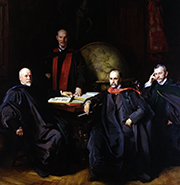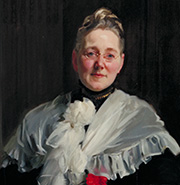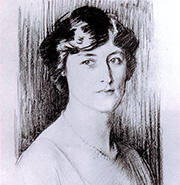John Singer Sargent
1856-1925
Sargent was born in Florence to American parents who had come to Italy for solace after the death of their first child. His father, Fitzwilliam Sargent, was an ophthalmologist who had served on the staff of Wills Hospital in Philadelphia. Mary Singer, his mother, was the daughter of a successful Philadelphia merchant. The couple chose to remain in Italy following the birth of their son and the later births of two daughters. Fitzwilliam gave up his medical career and raised his family on a modest independent income. Although the parents tutored the children, they were also able to provide them with art and music lessons from members of Florence’s thriving cultural community. Moreover, they traveled widely throughout Europe to provide additional learning opportunities for the children.
From an early age Sargent showed a natural talent and affinity for the visual arts. When he was in his teens, his parents enrolled him in Florence’s L’Accademia di Belle Arti for more concentrated formal training. In 1874 his family moved to Paris where he entered the atelier of Charles Augustus Emile Carolus-Duran. By the age of twenty-two, Sargent began to exhibit at the Paris Salon. Although the early works that he entered were generally admired, his portrait of Madame X which was featured at the 1884 Salon created great controversy among French critics. The main objections centered around the unconventional pose and the eroticism that it projected.
Early supporters of Sargent’s work, the novelist Henry James and the artist James McNeill Whistler, helped ease him through the Salon debacle by suggesting that he move to England and re-establish his career there. In 1886 he settled into the London studio on Tite Street that Whistler had vacated. For the next forty years it was the main center of his artistic activity, where patrons visited and sat for portraits.
In England he reclaimed his reputation as a masterful portrait artist and attracted many commissions from both sides of the Atlantic. His sitters included society figures, aristocrats, and other leading eminences. Although Sargent specialized primarily in portraiture, he also created a body of significant landscapes, murals, and works commemorating World War I.
Sargent’s works are included in the permanent collections of the Scottish National Portrait Gallery; Museum of Fine Arts, Boston; National Portrait Gallery, London; National Gallery of Art, Washington, DC; and in college and university collections, including those of Bryn Mawr, Harvard, and Johns Hopkins.
Portrait(s) by John Singer Sargent
"*" indicates required fields



